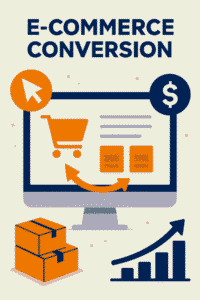
Generative AI is redefining ecommerce conversion by turning search bars into intelligent intent engines that guide shoppers to the right products faster, improving relevance, satisfaction, and sales.
As competition and costs rise, ecommerce sellers face increasing pressure to maximize every site visit. Conversion rates, once a passive metric, are now a critical lifeline.
Between 2000 and 2010, limited trust and clunky design kept conversion rates around 1.5%–2.5%. A decade later, better UX and payment tools nudged them to 2.5%–4%.
The pandemic pushed temporary spikes, but post-2020 rates have largely stabilized between 3%–4.2%. While personalization and mobile device optimization continue to anchor conversion rates in the 2%–4% range in 2025, reaching and maintaining that performance is becoming harder for sellers.
Stacking tariffs under the Trump administration increase costs across supply chains, forcing ecommerce brands to make tougher trade-offs between investing in customer’s shopping experience and protecting their bottom line.
AI-powered search raises the bar for e-commerce marketplace conversion
Shopify"A good ecommerce conversion rate is crucial to your store’s success. "
In an article on Ecommerce Times, it was reported that many e-commerce sites underperform because their online search capabilities frustrate shoppers. This poor experience often drives potential customers away, sometimes towards physical stores or competitors.
AI platforms, such as Coveo’s, aim to solve this by integrating generative AI with powerful search tools. The goal is to improve the customer experience at every step and reduce the gap between online shopping and in-store shopping interactions.
Recent consumer research by Coveo and Arlington Research highlights a growing demand for seamless AI integration. A survey found 62% of shoppers are more likely to buy when guided by AI, a figure rising to 68% among millennials.
Poor search experiences are a major reason shoppers leave websites, with 72% abandoning sites due to search issues. Common frustrations reported include:
- Irrelevant results that don’t match the search query.
- Too many product choices presented without useful sorting.
- Ineffective filters that fail to narrow down selections properly. These weaknesses make it difficult for customers to find the items they seek.
When online shoppers give up on a site’s search, 53% turn to Google, and 36% go directly to a competitor. This represents a significant loss of potential sales and negatively impacts the ecommerce conversion rate.
What Amazon sellers can leverage on
Datareportal"32.8% of internet users aged 16 and above discover new brands, products, and services via search engines."
Digital product discovery is critical, as 77% of consumers research online before purchasing, even for items bought in stores. While social media inspires many (73%), most transactions happen elsewhere, indicating a need for smooth pathways from social discovery to e-commerce purchase.
Consistency between online information and in-store reality is also vital for customer trust. AI tools can help by unifying data across channels to ensure consistent pricing, stock availability, and product details.
Knowing that almost 80% of consumers research online before buying (even if inspired elsewhere like social media), Amazon sellers need to ensure their Amazon product detail pages are comprehensive and provide all the answers shoppers seek during their discovery phase.
Build crucial buyer trust and drive higher conversion rates by maintaining absolute accuracy and consistency in your product information, pricing, and stock levels across Amazon and any external digital marketplace channels directing traffic to your listings.
Rufus, Amazon's AI-powered search assistant
Amazon Rufus, the company’s generative AI-powered shopping assistant, streamlines the product discovery process by delivering fast, relevant answers directly in the search experience. Instead of scrolling through pages of listings, shoppers can ask Rufus detailed questions and receive tailored product suggestions, comparisons, and recommendations in real time.
By understanding shopper intent and simplifying decision-making, Rufus reduces friction and helps customers find personalized results faster, ultimately boosting conversion rates for sellers.
Amazon and Walmart lead the pack in conversion rates and better customer experience
A Digital Commerce article reported that while many online retailers struggle to improve conversion rates, industry giants Amazon and Walmart demonstrate exceptional performance. Recent data from research firm YouGov showed these two companies leading not only other retailers but also brands across various sectors in purchase intent.
YouGov compared over 2,000 brands and found Amazon and Walmart’s ability to convert Browse shoppers into buyers significantly surpasses the estimated industry average of 12%. Amazon achieved a 77% consideration conversion rate, while Walmart reached 60%.
Their respective membership programs also ranked highly for converting shoppers relative to industry peers, with Amazon Prime at #3 and Walmart+ at #20. Other top online retailers noted for strong performance relative to their sectors included:
- Apple
- Costco
- Home Depot
- Skechers
The success of Amazon and Walmart in driving ecommerce conversion stems partly from robust omnichannel marketing strategies. Both offer versatile options like buy online, pick up in store (BOPIS) and extensive delivery networks, leveraging physical locations (Walmart stores, Amazon lockers/Whole Foods).
Strong personalization efforts, fueled by vast amounts of first-party customer data, are another major factor. Amazon, for instance, recently introduced features like “Interests” to aid product discovery and improve the relevance of its offerings.
The high ranking of their paid membership programs further underscores the vital role these operations play. Both Prime and Walmart+ effectively use member data to enhance personalization and drive higher conversion rates.
Ecommerce conversion optimization on Amazon
Earlier this month, Amazon Advertising announced a significant update to its Sponsored Display campaigns, shifting all active Reach and Page Visit campaigns to now optimize for conversion opportunities.
The update enhances the platform’s machine learning algorithm to better identify high-conversion prospects and drive incremental sales.
Previously, advertisers could choose between optimization goals (Reach, Page Visits, or Conversions) based on their campaign objectives. With this change, all existing Reach and Page Visit campaigns will now align with conversion-based optimization, potentially improving key metrics like ROAS and ACOS.
Sponsored Display remains a flexible, self-serve ad solution, allowing brands of all sizes to reach targeted audiences across Amazon-owned properties and its third-party network. Amazon’s goal is to increase campaign efficiency while meeting advertisers’ growing expectations for sales-focused performance.
The updated optimization applies across numerous regions, including:
North America: U.S., Canada, Mexico
South America: Brazil
Europe: U.K., Germany, France, Italy, Spain, and more
Asia-Pacific: India, Japan, China, Australia, Singapore, among others
Middle East and Africa: Saudi Arabia, UAE, Israel, South Africa, and more
Advertisers with active Reach or Page Visit campaigns, or the Amazon agency managing their accounts, can access the updated features via the Amazon Advertising Console or Ads API.
Ecommerce conversion goes beyond checkout
Ecommerce conversion isn’t just about completing a purchase; it’s the sum of small actions that guide a shopper toward checkout process. According to Hotjar, optimizing these micro-conversions can significantly improve overall revenue by reducing friction and improving user experience throughout the buying journey.
Adding products to cart
The “add to cart” action is a strong signal of buying intent. According to Kibo Commerce, the average U.S. add-to-cart rate is 11%, highlighting the need for compelling product pages that drive engagement.
Using the site search
Shoppers who use your site’s search bar often know exactly what they want. The Hotjar article explains that these users tend to convert at higher rates, making optimized search functionality a high-impact area for conversion improvement.
Signing up for emails
Email sign-ups are valuable micro-conversions that help build long-term customer relationships. To boost opt-in rates, ecommerce brands should offer meaningful incentives and understand their audience’s needs.






